自动检测技术运用及发展外文文献翻译上课讲义
外文参考文献翻译-中文
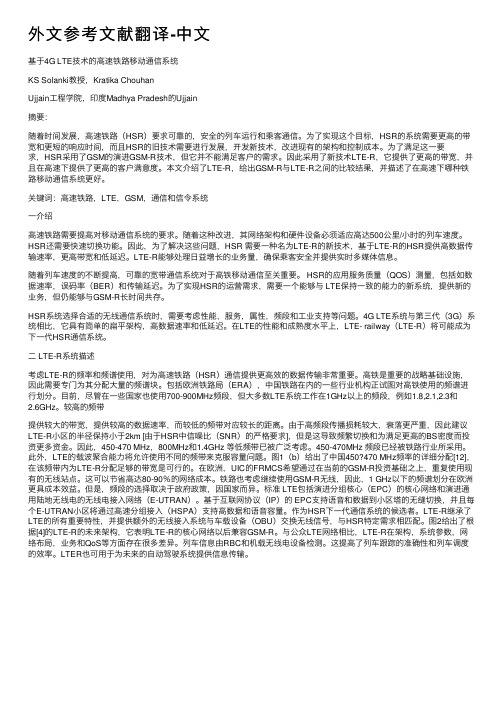
外⽂参考⽂献翻译-中⽂基于4G LTE技术的⾼速铁路移动通信系统KS Solanki教授,Kratika ChouhanUjjain⼯程学院,印度Madhya Pradesh的Ujjain摘要:随着时间发展,⾼速铁路(HSR)要求可靠的,安全的列车运⾏和乘客通信。
为了实现这个⽬标,HSR的系统需要更⾼的带宽和更短的响应时间,⽽且HSR的旧技术需要进⾏发展,开发新技术,改进现有的架构和控制成本。
为了满⾜这⼀要求,HSR采⽤了GSM的演进GSM-R技术,但它并不能满⾜客户的需求。
因此采⽤了新技术LTE-R,它提供了更⾼的带宽,并且在⾼速下提供了更⾼的客户满意度。
本⽂介绍了LTE-R,给出GSM-R与LTE-R之间的⽐较结果,并描述了在⾼速下哪种铁路移动通信系统更好。
关键词:⾼速铁路,LTE,GSM,通信和信令系统⼀介绍⾼速铁路需要提⾼对移动通信系统的要求。
随着这种改进,其⽹络架构和硬件设备必须适应⾼达500公⾥/⼩时的列车速度。
HSR还需要快速切换功能。
因此,为了解决这些问题,HSR 需要⼀种名为LTE-R的新技术,基于LTE-R的HSR提供⾼数据传输速率,更⾼带宽和低延迟。
LTE-R能够处理⽇益增长的业务量,确保乘客安全并提供实时多媒体信息。
随着列车速度的不断提⾼,可靠的宽带通信系统对于⾼铁移动通信⾄关重要。
HSR的应⽤服务质量(QOS)测量,包括如数据速率,误码率(BER)和传输延迟。
为了实现HSR的运营需求,需要⼀个能够与 LTE保持⼀致的能⼒的新系统,提供新的业务,但仍能够与GSM-R长时间共存。
HSR系统选择合适的⽆线通信系统时,需要考虑性能,服务,属性,频段和⼯业⽀持等问题。
4G LTE系统与第三代(3G)系统相⽐,它具有简单的扁平架构,⾼数据速率和低延迟。
在LTE的性能和成熟度⽔平上,LTE- railway(LTE-R)将可能成为下⼀代HSR通信系统。
⼆ LTE-R系统描述考虑LTE-R的频率和频谱使⽤,对为⾼速铁路(HSR)通信提供更⾼效的数据传输⾮常重要。
《自动检测技术及应用》(全套课件361P)上

l l R 2 A r 当沿金属丝的长度方向作用均匀拉力(或压力) 时,上式中 、 r 、 l 都将发生变化,从而导致电阻 值R发生变化。
例如金属丝受拉时,l将变长、r变小,均导致R变大; 又如,某些半导体受拉时,将变大,导致R变大。
实验证明,电阻丝及应变片的电阻相对变化量 R/R与材料力学中的轴向应变x(x= l/l)的关 系在很大范围内是线性的,即
自动检测技术及应用
一、课程简介:
• 课程性质:专业应用技术学科
• 主要内容:传感器技术,检测方法,误差
理论,抗干扰技术等。
• 主要任务:获得传感器的基本知识和自动
检测方法,抗干扰技术等方面
的基本技能。
二、教学安排
• 时间:1~14周,共14周,56学时
• 建议:1)不迟到、旷课,课堂纪律好(个人修养) 2)端正学习态度,注意学习方法 要有一个良好的学习心态 养成一个良好的学习习惯(学习能力)
x=F/AE
而 R/R=Kx
故:R/R=KF/AE
(E为弹性模量)
如果应变片的灵敏度K和试件的横截面积A以及弹 性模量E均为已知,则只要设法测出R/R的数值 ,即可获知试件受力F的大小。
R K x R K—电阻应变片的灵敏度
2-1
对于不同的金属材料,K略微不同,一般为2左右。 而对半导体材料而言,由于其感受到应变时,电阻率 会产生很大的变化,所以灵敏度比金属材料大几十倍。
在材料力学中, x =l/l 称为电阻丝的轴向应变,
也称纵向应变。x通常很小,常用10-6表示之。
传感器
微机
执行器 机 器
2、现代信息技术的三大基础:
信息采集 信息传输 信息处理
传感器技术
自动化专业英语原文和翻译

自动化专业英语原文和翻译引言概述:自动化是现代工程技术领域中的重要学科,它涉及到自动控制系统、机器人技术、传感器技术等多个领域。
在自动化专业中,学习和掌握英语是必不可少的,因为英语是国际通用语言,也是自动化领域中的重要交流工具。
本文将介绍一些常见的自动化专业英语原文和翻译,以帮助学习者更好地理解和运用这些术语。
一、自动化概念及应用1.1 自动化定义英文原文:Automation refers to the use of technology to control and operate processes or systems without human intervention.翻译:自动化是指利用技术来控制和操作过程或系统,无需人为干预。
1.2 自动化应用领域英文原文:Automation is widely applied in manufacturing, transportation, healthcare, and many other industries.翻译:自动化广泛应用于制造业、交通运输、医疗保健等许多行业。
1.3 自动化优势英文原文:Automation offers advantages such as increased productivity, improved efficiency, and enhanced safety.翻译:自动化提供了增加生产力、提高效率和增强安全性等优势。
二、自动控制系统2.1 自动控制系统定义英文原文:An automatic control system is a set of devices that manage and regulate the behavior of a system or process automatically.翻译:自动控制系统是一组设备,能够自动管理和调节系统或过程的行为。
2.2 自动控制系统组成英文原文:An automatic control system consists of sensors, actuators, controllers, and communication networks.翻译:自动控制系统由传感器、执行器、控制器和通信网络组成。
自动检测技术ppt课件

特点: 综合性(机、光、电一体),先进性(学科发展), 广泛性,传成性 软硬件结合
应用: 1、产品检测和质量控制 2、安全经济运行监测 3 、自动化技术四个支柱之一 4、推动科技发展
检测技术在国民经济中的地位和作用
一目了然
数字式仪表
数字式仪表 的特点: 准确,但最 后一位经常 跳动不止。
热敏电阻
LED、LCD的特点:
LED亮度高、耐振动;LCD耗电省、集成度高, 但不利于夜间观察。
带背光板的LCD可以在夜间观看
特点——
能显示复杂的 图形和曲线,
但价格昂贵。
图像显示
图像显示(续)
带RS-232接口的万用表及图像显示
工业检测涉及的内容(续)
物体的性质和成分量: 空气的湿度(绝对、相对)、气体的化学成分、浓度、
液体的粘度、浊度、透明度、物体的颜色 状态量:
工作机械的运动状态(启停等)、生产设备的异常状态 (超温、过载、泄漏、变形、磨损、堵塞、断裂等)
电工量(U、I、f、R、Z、E、B ……在电工、电子等课程
一种典型的自动检测系统
(检测系统在发电厂的应用) .
传感器简介:
①传感器是测量装置,能完成检测任务;
②输入量是某一被测量,可能是物理量,也可能是化学量、
生物量等;
V、I、F、P
③输出量是某种物理量,便于传输、转换、处理、显示等,
可以是气、光、电物理量,主要是电物理量;
④输出输入有对应关系,且应有一定的精确程度。
检测技术在卫星中的应用 红外扫 描区域
人造卫星
检测技术在海啸预报中的应用
第九章自动检测技术的综合应用概要PPT课件
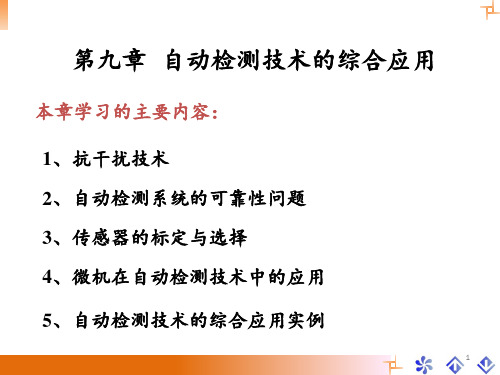
(3) 数字滤波
从一系列数据中提取逼近真值数据的软件算法。
.
44
(4) 线性化处理 对传感器的非线性可以运用软件技术来实现非
线性校正。
(5) 温度的补偿
系统受温度的影响可用软件来补偿。
(6) 数据运算、比较与处理
(7)数据输出
测量数据的输出包括输出显示、打印、通讯等,
控制数据的输出包括报警、控制执行元件来调整被
(4)键盘及显示
键盘根据需要只设置七个键;显示分两部分:6 位LED显示器用于运行状态及温度、时间显示,通过 SB键进行温度、时间显示转换;6个发光二极管分别 用于升温、降温、恒温、运行、超温及故障显示。
.
50
3.系统软件部分 (1)主程序
主程序框图
.
51
(2)运行程序
运 行 程 序 框 图
.
52
(3)辐射电磁场耦合形成的干扰
辐射电磁场通常来源于大功率高频电气设备、
广播发射台、电视发射台等。如果在辐射电磁场中 放置一个导体,则在导体上产生正比于电场强度的 感应电动势。
.
15
四、抑制电磁干扰的基本措施
电磁干扰形成的三个要素为干扰源、干扰途 径以及对电磁噪声敏感性较高的接收电路。
干扰源
干扰途径
4.平衡电路
平衡电路又称对称电路。例如,电桥电路和 差分放大器等电路就属于平衡电路。采用平衡电 路可以使对称电路结构所获得噪声相等,并可以 在负载上自行抵消。
.
27
5.滤波技术
滤波器是抑制噪声干扰的重要手段之一。常 用的是RC型、LC型及双T 型等形成的无源滤波器 或有源滤波器。
滤波器抑制检测系统干扰的原理框图
定的时间内,在规定的条件下,完成规定功能的能 力。
自动检测技术及应用》教案
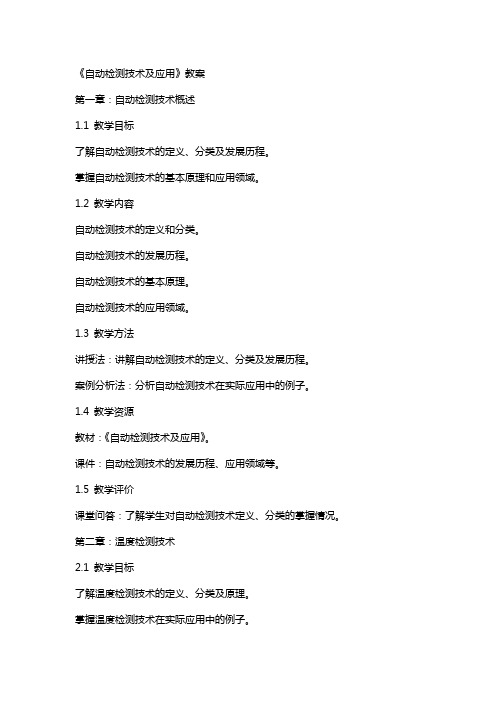
《自动检测技术及应用》教案第一章:自动检测技术概述1.1 教学目标了解自动检测技术的定义、分类及发展历程。
掌握自动检测技术的基本原理和应用领域。
1.2 教学内容自动检测技术的定义和分类。
自动检测技术的发展历程。
自动检测技术的基本原理。
自动检测技术的应用领域。
1.3 教学方法讲授法:讲解自动检测技术的定义、分类及发展历程。
案例分析法:分析自动检测技术在实际应用中的例子。
1.4 教学资源教材:《自动检测技术及应用》。
课件:自动检测技术的发展历程、应用领域等。
1.5 教学评价课堂问答:了解学生对自动检测技术定义、分类的掌握情况。
第二章:温度检测技术2.1 教学目标了解温度检测技术的定义、分类及原理。
掌握温度检测技术在实际应用中的例子。
2.2 教学内容温度检测技术的定义和分类。
温度检测技术的基本原理。
温度检测技术在实际应用中的例子。
2.3 教学方法讲授法:讲解温度检测技术的定义、分类及原理。
案例分析法:分析温度检测技术在实际应用中的例子。
2.4 教学资源教材:《自动检测技术及应用》。
课件:温度检测技术的原理、实际应用等。
2.5 教学评价课堂问答:了解学生对温度检测技术定义、分类的掌握情况。
课后作业:要求学生分析一个温度检测技术在实际应用中的例子。
第三章:压力检测技术3.1 教学目标了解压力检测技术的定义、分类及原理。
掌握压力检测技术在实际应用中的例子。
3.2 教学内容压力检测技术的定义和分类。
压力检测技术的基本原理。
压力检测技术在实际应用中的例子。
3.3 教学方法讲授法:讲解压力检测技术的定义、分类及原理。
案例分析法:分析压力检测技术在实际应用中的例子。
3.4 教学资源教材:《自动检测技术及应用》。
课件:压力检测技术的原理、实际应用等。
3.5 教学评价课堂问答:了解学生对压力检测技术定义、分类的掌握情况。
课后作业:要求学生分析一个压力检测技术在实际应用中的例子。
第四章:流量检测技术4.1 教学目标了解流量检测技术的定义、分类及原理。
测控技术与仪器 自动化 外文翻译 外文文献 英文文献

外文出处:资料1:Virtual instrument based on serial(用外文写)communication and data acquisition system of management .资料2:LabVIEW serial communication based on Frequency Control Monitoring System附件:资料1:1.翻译译文;2.外文原文。
资料2:1.翻译译文;2.外文原文。
附件:资料1翻译译文在自动化控制和智能仪器仪表中, 单片机的应用越来越广泛, 由于单片机的运算功能较差, 往往需要借助计算机系统, 因此单片机和 PC机进行远程通信更具有实际意义, 通信的关键在于互传数据信息。
51系列单片机内部的串行口具有通信的功能,该串行口可以作为通信接口, 利用该串行口与 PC机的串行口 COM 1或COM 2进行串行通信, 将单片机采集的数据传送到 PC机中, 由 PC机的高级语言或数据库语言对数据进行整理及统计等复杂处理就能满足实际的应用需要。
软件设计,初始化后,打开数据通道对上下游信号进行采样,并进行相关运算,求峰值R~,对R.二是否峰值进行判断,以确保正确求出延时r,从而得出正确的流量。
由于一次相关计算所需时间很短,因此,采用计数器控制。
PC机和单片机在进行通信时, 首先分别对各自的串行口进行初始化、确定串行口工作方式、设定波特率、传输数据长度等, 然后才开始数据传输, 这些工作是由软件来完成的, 因此对 PC机和单片机均需设计相应的通信软件。
DOS环境下, 串行通信一般用中断方式来实现,用户对通信端口进行完全控制。
而在 W i ndow s 环境下, 系统禁止应用程序直接对硬件进行操作。
在W indows环境下提供了完备的 AP I应用程序接口函数, 程序员通过这些函数与通信硬件接口。
通信函数是中断驱动的: 发送数据时, 先将其放入缓存区,串口准备好后, 就将其发送出去; 传来的数据迅速申请中断, 使 W i ndow s接收它并将其存入缓冲区, 以供读取。
自动检测技术及应用》教案
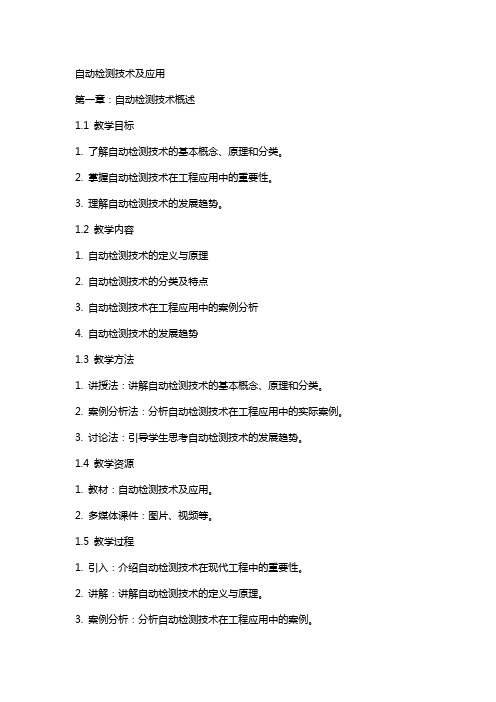
自动检测技术及应用第一章:自动检测技术概述1.1 教学目标1. 了解自动检测技术的基本概念、原理和分类。
2. 掌握自动检测技术在工程应用中的重要性。
3. 理解自动检测技术的发展趋势。
1.2 教学内容1. 自动检测技术的定义与原理2. 自动检测技术的分类及特点3. 自动检测技术在工程应用中的案例分析4. 自动检测技术的发展趋势1.3 教学方法1. 讲授法:讲解自动检测技术的基本概念、原理和分类。
2. 案例分析法:分析自动检测技术在工程应用中的实际案例。
3. 讨论法:引导学生思考自动检测技术的发展趋势。
1.4 教学资源1. 教材:自动检测技术及应用。
2. 多媒体课件:图片、视频等。
1.5 教学过程1. 引入:介绍自动检测技术在现代工程中的重要性。
2. 讲解:讲解自动检测技术的定义与原理。
3. 案例分析:分析自动检测技术在工程应用中的案例。
4. 讨论:探讨自动检测技术的发展趋势。
5. 总结:回顾本节课的重点内容。
第二章:传感器技术2.1 教学目标1. 了解传感器的基本概念、分类和性能指标。
2. 掌握常见传感器的原理及应用。
3. 了解传感器信号处理方法。
2.2 教学内容1. 传感器的基本概念与分类2. 传感器的性能指标3. 常见传感器的原理及应用4. 传感器信号处理方法2.3 教学方法1. 讲授法:讲解传感器的基本概念、分类和性能指标。
2. 实例讲解法:介绍常见传感器的原理及应用。
3. 讨论法:分析传感器信号处理方法。
2.4 教学资源1. 教材:自动检测技术及应用。
2. 多媒体课件:图片、视频等。
2.5 教学过程1. 引入:介绍传感器在自动检测技术中的重要性。
2. 讲解:讲解传感器的基本概念与分类。
3. 实例讲解:介绍常见传感器的原理及应用。
4. 讨论:分析传感器信号处理方法。
5. 总结:回顾本节课的重点内容。
第三章:自动检测系统的设计与实现3.1 教学目标1. 掌握自动检测系统的设计步骤。
2. 了解自动检测系统的组成及功能。
自动检测技术及应用》教案

《自动检测技术及应用》教案第一章:自动检测技术概述1.1 检测技术的定义与发展1.2 自动检测技术的基本原理1.3 自动检测技术的作用与意义1.4 本章小结第二章:传感器与检测仪表2.1 传感器的概念与分类2.2 传感器的性能指标与选择2.3 常见传感器的工作原理与应用2.4 检测仪表的基本组成与功能2.5 本章小结第三章:模拟信号处理技术3.1 模拟信号处理的基本方法3.2 信号滤波器的设计与实现3.3 信号采样与量化3.4 信号处理电路的设计与应用3.5 本章小结第四章:数字信号处理技术4.1 数字信号处理的基本原理4.2 数字滤波器的设计与实现4.3 快速傅里叶变换(FFT)4.4 数字信号处理的应用案例4.5 本章小结第五章:自动检测系统的设计与实现5.1 自动检测系统的设计流程5.2 系统硬件的设计与选型5.3 系统软件的设计与实现5.4 自动检测系统的性能评估与优化5.5 本章小结第六章:工业自动化中的自动检测技术6.1 工业自动化系统简介6.2 温度检测技术与应用6.3 压力检测技术与应用6.4 流量检测技术与应用6.5 位置检测技术与应用6.6 本章小结第七章:生物医学中的自动检测技术7.1 生物医学检测的意义与挑战7.2 生物组织检测技术与应用7.3 生物分子检测技术与应用7.4 细胞检测技术与应用7.5 生理参数检测技术与应用7.6 本章小结第八章:交通运输中的自动检测技术8.1 交通运输系统与自动检测技术8.2 车辆检测技术与应用8.3 交通流量检测技术与应用8.4 轨道检测技术与应用8.5 桥梁与结构检测技术与应用8.6 本章小结第九章:环境监测中的自动检测技术9.1 环境监测的重要性9.2 空气质量检测技术与应用9.3 水质量检测技术与应用9.4 土壤质量检测技术与应用9.5 噪声检测技术与应用9.6 本章小结第十章:自动检测技术的未来发展趋势10.1 新型传感器的研究与应用10.2 与机器学习在自动检测领域的应用10.3 物联网技术与自动检测系统的融合10.4 量子检测技术的发展前景10.5 本章小结第十一章:自动检测技术在制造过程中的应用11.1 制造过程自动化概述11.2 在线检测与监控技术11.3 机器视觉检测技术11.4 声音与振动分析检测技术11.5 生产过程质量控制与优化11.6 本章小结第十二章:自动检测技术在能源领域的应用12.1 能源监测与管理的重要性12.2 电力系统检测技术12.3 石油与天然气检测技术12.4 renewable energy检测技术12.5 能源消耗优化与故障诊断12.6 本章小结第十三章:自动检测技术在安全监控中的应用13.1 安全监控系统的重要性13.2 视频监控技术13.3 生物特征识别检测技术13.4 火灾报警检测技术13.5 自然灾害预警与监测技术13.6 本章小结第十四章:自动检测技术在信息技术领域的应用14.1 信息技术与自动检测技术的关系14.2 网络流量监测技术14.3 数据存储与完整性检测技术14.4 软件质量检测技术14.5 信息技术设备性能检测技术14.6 本章小结第十五章:自动检测技术的综合应用与案例分析15.1 自动检测技术的集成与应用15.2 智能家居中的自动检测技术15.3 无人驾驶车辆的自动检测技术15.4 智能物流系统中的自动检测技术15.5 自动检测技术在医疗设备中的应用15.6 本章小结重点和难点解析重点:1. 自动检测技术的定义与发展2. 传感器与检测仪表的种类、性能指标与选择3. 模拟信号处理和数字信号处理的基本方法4. 自动检测系统的设计与实现流程5. 自动检测技术在工业自动化、生物医学、交通运输、环境监测等领域的应用案例6. 新型传感器、、物联网和量子检测技术的发展趋势难点:1. 传感器的内部工作机制和复杂信号的处理方法2. 数字信号处理中的快速傅里叶变换(FFT)算法3. 自动检测系统硬件设计和软件编程4. 不同领域特定检测技术的原理与应用5. 自动检测技术的集成和优化方法通过学习本教案,学生将能够全面了解自动检测技术的基本原理、应用领域和发展趋势,并为实际工程应用打下坚实的基础。
自动检测技术及应用资料(收集的完全版)
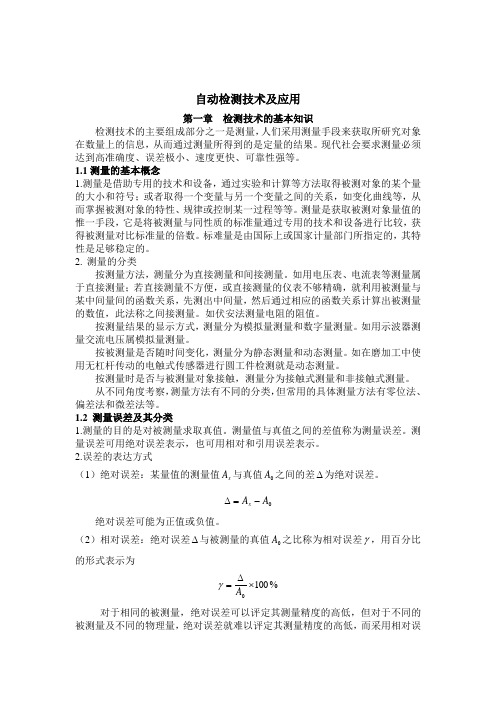
自动检测技术及应用第一章 检测技术的基本知识检测技术的主要组成部分之一是测量,人们采用测量手段来获取所研究对象在数量上的信息,从而通过测量所得到的是定量的结果。
现代社会要求测量必须达到高准确度、误差极小、速度更快、可靠性强等。
1.1测量的基本概念1.测量是借助专用的技术和设备,通过实验和计算等方法取得被测对象的某个量的大小和符号;或者取得一个变量与另一个变量之间的关系,如变化曲线等,从而掌握被测对象的特性、规律或控制某一过程等等。
测量是获取被测对象量值的惟一手段,它是将被测量与同性质的标准量通过专用的技术和设备进行比较,获得被测量对比标准量的倍数。
标难量是由国际上或国家计量部门所指定的,其特性是足够稳定的。
2. 测量的分类按测量方法,测量分为直接测量和间接测量。
如用电压表、电流表等测量属于直接测量;若直接测量不方便,或直接测量的仪表不够精确,就利用被测量与某中间量间的函数关系,先测出中间量,然后通过相应的函数关系计算出被测量的数值,此法称之间接测量。
如伏安法测量电阻的阻值。
按测量结果的显示方式,测量分为模拟量测量和数字量测量。
如用示波器测量交流电压属模拟量测量。
按被测量是否随时间变化,测量分为静态测量和动态测量。
如在磨加工中使用无杠杆传动的电触式传感器进行圆工件检测就是动态测量。
按测量时是否与被测量对象接触,测量分为接触式测量和非接触式测量。
从不同角度考察,测量方法有不同的分类,但常用的具体测量方法有零位法、偏差法和微差法等。
1.2 测量误差及其分类1.测量的目的是对被测量求取真值。
测量值与真值之间的差值称为测量误差。
测量误差可用绝对误差表示,也可用相对和引用误差表示。
2.误差的表达方式(1)绝对误差:某量值的测量值x A 与真值0A 之间的差∆为绝对误差。
0A A x -=∆绝对误差可能为正值或负值。
(2)相对误差:绝对误差∆与被测量的真值0A 之比称为相对误差γ,用百分比的形式表示为%1000⨯∆=A γ 对于相同的被测量,绝对误差可以评定其测量精度的高低,但对于不同的被测量及不同的物理量,绝对误差就难以评定其测量精度的高低,而采用相对误差来评定较为确切。
《自动检测技术及应用》教案
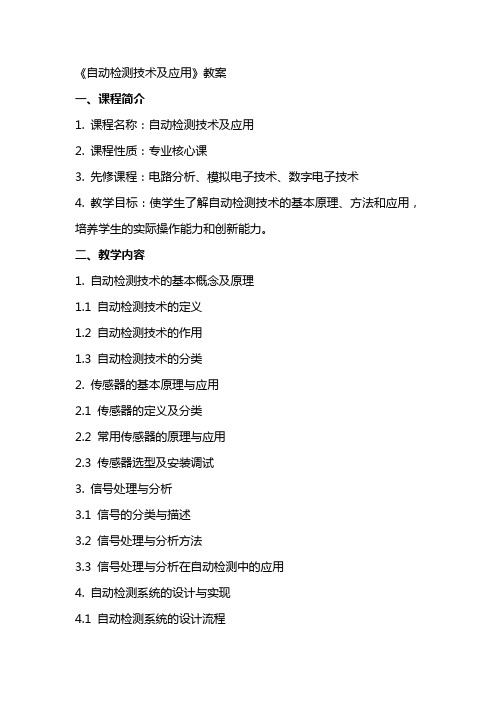
《自动检测技术及应用》教案一、课程简介1. 课程名称:自动检测技术及应用2. 课程性质:专业核心课3. 先修课程:电路分析、模拟电子技术、数字电子技术4. 教学目标:使学生了解自动检测技术的基本原理、方法和应用,培养学生的实际操作能力和创新能力。
二、教学内容1. 自动检测技术的基本概念及原理1.1 自动检测技术的定义1.2 自动检测技术的作用1.3 自动检测技术的分类2. 传感器的基本原理与应用2.1 传感器的定义及分类2.2 常用传感器的原理与应用2.3 传感器选型及安装调试3. 信号处理与分析3.1 信号的分类与描述3.2 信号处理与分析方法3.3 信号处理与分析在自动检测中的应用4. 自动检测系统的设计与实现4.1 自动检测系统的设计流程4.2 自动检测系统的硬件选型与配置4.3 自动检测系统的软件设计与开发5. 自动检测技术的应用案例分析5.1 工业生产过程中的自动检测5.2 生物医学领域的自动检测5.3 环境监测与保护的自动检测三、教学方法与手段1. 教学方法:采用讲授、实验、案例分析相结合的教学方法。
2. 教学手段:多媒体课件、实验设备、网络资源等。
四、教学评价1. 平时成绩:包括课堂表现、作业完成情况、实验报告等,占总评的40%。
2. 考试成绩:包括期末考试和课程设计,占总评的60%。
五、教学计划1. 课时安排:共计48课时,其中理论教学32课时,实验教学16课时。
2. 教学进度安排:第一周:自动检测技术的基本概念及原理第二周:传感器的基本原理与应用第三周:信号处理与分析第四周:自动检测系统的设计与实现第五周:自动检测技术的应用案例分析六、教学资源1. 教材:《自动检测技术及应用》,作者:,出版社:机械工业出版社,出版日期:2024年。
2. 实验设备:传感器实验箱、信号发生器、示波器、数据采集器等。
3. 网络资源:相关学术论文、技术博客、行业动态等。
七、教学活动1. 课堂讲授:通过PPT等多媒体课件,生动形象地展示自动检测技术的基本概念、原理和应用。
- 1、下载文档前请自行甄别文档内容的完整性,平台不提供额外的编辑、内容补充、找答案等附加服务。
- 2、"仅部分预览"的文档,不可在线预览部分如存在完整性等问题,可反馈申请退款(可完整预览的文档不适用该条件!)。
- 3、如文档侵犯您的权益,请联系客服反馈,我们会尽快为您处理(人工客服工作时间:9:00-18:30)。
自动检测技术的运用与发展自动检测系统广泛应用于各类产品的设计、生产、使用、维护等各个阶段,对提高产品性能及生产率、降低生产成本及整个生产周期成本起着重要作用。
本文首先介绍自动检测系统的概念,其次通过自动检测系统的各个组成部分,详述系统的工作原理,介绍了自动检测系统组建的概念、结构以及在组建中所使用的关键技术。
以此为铺垫,进而深入探讨自动检测技术在各领域间的应用与推广1.自动检测系统的概念与组成自动检测技术是一种尽量减少所需人工的检测技术,是一种依赖仪器仪表,涉及物理学、电子学等多种学科的综合性技术。
与传统检测技术相比,这一技术可以减少人们对检测结果有意或无意的干扰,减轻人员的工作压力,从而保证了被检测对象的可靠性,因此自动检测技术已经成为社会发展不可或缺的重要部分。
自动检测技术主要有两项职责,一方面,通过自动检测技术可以直接得出被检测对象的数值及其变化趋势等内容;另一方面,将自动检测技术直接测得的被检测对象的信息纳入考虑范围,从而制定相关决策。
检测和检验是制造过程中最基本的活动之一。
通过检测和检验活动提供产品及其制造过程的质量信息,按照这些信息对产品的制造过程进行修正,使废次品与反修品率降至最低,保证产品质量形成过程的稳定性及产出产品的一致性。
传统的检测和检验主要依赖人,并且主要靠手工的方式来完成。
传统的检验和检测是在加工制造过程之后进行,一旦检出废次品,其损失已发生。
基于人工检测的信息,经常包含人的误差影响,按这样的信息控制制造过程,不仅要在过程后才可以实施,而且也会引入误差。
自动检测是以多种先进的传感技术为基础的,且易于同计算机系统结合,在合适的软件支持下,自动地完成数据采集、处理、特征提取和识别,以及多种分析与计算。
而达到对系统性能的测试和故障诊断的目的。
1.1检测与检验的概念检测是指为确定产品、零件、组件、部件或原材料是否满足设计规定的质量标准和技术要求目标值而进行的测试、测量等质量检测活动,检测有3个目标:1.实际测定产品的规定质量我及其指标的量值。
2.根据测得值的偏离状况,判定产品的质量水平,确定废次品。
3.认定测量方法的正确性和对测量活动简化是否会影响对规定特征的控制。
检验,又称试验,他是对产品功能和性能进行评定的一种质量控制方法。
检验指的是在实际工作环境或设计规定的工作条件下,对产品的功能、性能和寿命进行测定、试验和评价的质量控制活动。
检验分为破坏性试验和无损检测试验两大类。
产品的检验评价是设计改进和修改、制造过程改善的依据,特别是要求安全认证的产品。
1.2自动检测系统的概念自动检测是指在计算机控制的基础上,对系统、设备进行性能检测和故障诊断。
他是性能检测、连续监测、故障检测和故障定位的总称。
现代自动检测技术是计算机技术、微电子技术、测量技术、传感技术等学科共同发展的产物。
凡是需要进行性能测试和故障诊断的系统、设备,均可以采用自动检测技术。
自动检测系统是指能自动完成测量、数据处理、显示(输出)测试结果的一类系统的总称。
他是在标准的测控系统总线和仪器总线的基础上组合而成,采用计算机、微处理器作控制器通过测试软件完成对性能数据的采集、变换、处理、显示等操作程序,具有高速度、多功能、多参数等特点。
2. 自动检测系统的原理2.1自动检测系统的组成当前自动检测系统的基本组成如图所示,包括控制器、激励信号源、测量仪器、开关系统、适配器、人机接口、检测程序。
2.2自动检测系统的工作原理控制器,自动检测系统的核心,由计算机组成。
它是在检测程序的作用下,对检测周期内的每一步骤进行控制,完成管理检测周期、控制数据流向、接收检测结果、进行数据处理、检查读数是否在误差范围内、进行故障诊断、将检测结果送到显示器等功能。
激励信号源,主要应用于主动式检测系统,它向被测单元提供检测所需的激励信号。
测量仪器,检测被测单元的输出信号。
开关系统,控制被测单元和自动检测系统中有关部件间的信号通道。
即控制激励信号输入被测单元,和被测单元的被测信号输往测量装置的信号通道。
适配器,实现被测单元与自动检测系统之间的信号连接。
人机接口,实现操作员和控制器的双向通信。
操作员用键盘或开关向控制器输入信息控制器将检测结果及操作提示等有关信息送到显示器显示。
当需要打印检测结果时,人机接口内应配备打印机。
机接口、检测程序。
检测程序,自动检测系统是在检测程序的控制下进行性能检测和故障诊断的。
检测程序完成人机交互、仪器管理和驱动、检测流程控制、检测结果的分析处理和输出显示、故障诊断等,他是自动检测系统的重要组成部分。
2.3自动检测系统的组建计算机技术的发展为自动检测系统的组建提供了多种可能,典型的自动检测系统包括三部分:自动检测设备(Automatic Test Equipment,ATE)、测试程序集(Test Program Set,TPS)和TPS软件开发工具. 自动检测系统组建中的关键技术包括程控接口技术、虚拟仪器技术、专家系统、现场故障检测技术、开放或可互操作的ATS实现技术。
3.自动检测技术的应用检测技术与自动化装置的应用基础是扎实的理论以及科研和工程实践过程中不断积累的新技术,加上学科基础理论和光、机、电结合导致技术的迅速发展,更加促进了检测技术与自动化装置学科的发展。
4.自动检测技术的发展随着半导体和计算机技术的发展,新型或具有特殊功能的传感器出现出现,检测装置也向小型化、固体化及智能化发展,应用领域更加宽广。
首先,不断提高监测系统的测量精度、量程范围、延长使用寿命、提高可靠性。
科学技术的发展要求测量系统有更高的精度。
近年来,人们研制出许多高精度的检测仪器以满足各种需求。
例如,用直线光栅测量直线位移时,测量范围可达二三米,而分辨率可达到微米级;人们已经研制出测量低至几个帕的微压力和高达几千兆帕高压的;力传感器;开发了能够测出极微弱磁场的磁敏传感器等。
从20世纪60年代开始,人们对传感器的可靠性和故障率的数学模型进行了大量的研究,使得监测系统的可靠性和使用寿命大幅度提高。
其次,应用新技术和新的物理效应,扩大检测领域。
检测原理大多以各种物理效应为基础,近代物理学的进展如纳米技术、激光、红外、超声波、微波、光纤、放射性同位素等新成就为检测技术的发展提供了更多的依据。
如图像识别、激光测距、红外测温、C型超声波无损探伤。
放射性测厚。
中子探测爆炸物等非接触测量得到迅速发展。
20世纪70年代以前,检测技术主要用于工业部门,如今,检测领域正扩大到整个社会需要的各个方面,不仅包括工程、海洋开发、航空航天等尖端科技和新兴工业领域,而且已涉及生物、医疗、环境污染监测、危险品和毒品的侦查、安全检测等方面,并且已经开始渗入到人们的日常生活设施之中。
再次,发展集成化、功能化的传感器。
随着半导体集成电路技术的发展,硅和砷化镓电子元件的高度集成化大量向传感器领域渗透。
人们将传感技术与信号处理电路制作在同一块硅片上,从而研制体积更小、性能更好、功能更强的传感器。
例如,高精度的PN结测温集成电路;又如,将排成阵列的上千万个光敏元件及扫描放大电路制作在一块芯片上,制成彩色CCD数码照相机、摄像机以及可摄像的手机等。
今后还将在光、磁、温度、压力等领域开发出新型的集成度很高的传感器。
第四,采用计算机技术,使检测技术智能化。
自20世纪70年代微处理器问世以来,人们迅速将计算机技术应用到测量技术领域中来,使检测仪器智能化,从而扩展了功能,提高了精度和可靠性,目前研制的测量系统大多带有微处理器。
第五,发展网络化传感器及检测系统。
随着微电子技术的发展,现在已经可以将十分复杂的信号处理和控制电路集成到单块的芯片中去。
传感器的输出不再是模拟量,而是符合某种协议格式(如可即插即用)的数字信号。
从而可以通过企业内部网络,也可以通过网络实现多个系统之间的数据交换和共享,从而构成网络化的检测系统。
还可以远在千里之外,随时随地浏览现场工况,实现远程调试、远程故障诊断。
远程数据采集和实时操作。
5.总结随着信息技术和计算计技术的发展,大量的技术成果被应用到自动检测技术当中,促进了自动检测技术的快速发展。
目前,自动检测技术已经应用到社会生产的各个领域,因此其功能极为强大;自动检测技术所需人员很少,因此可靠性较高;自动检测技术测得的被检测对象的参数信息基本不会受到来自人的随机干扰,因此精确度较高;运用自动检测技术的测量过程主要是自动完成的,只要测量之间设置好时间、程序等指数,就可以很好地完成测量工作,因此实时性很强。
自动检测系统从被检测对象出发,经传感器等检测元件将被检测对象转化为信号,通过复杂的变换过程进行信号处理,最终将信号输出。
近年来计算计技术和物理科学的不断更新为自动检测技术的发展创造了可能。
自动检测技术能够采用更加先进的检测方法,应用范围也更加广泛。
自动检测技术在高新领域的广泛运用,形成了具有现代特点的智能检测技术。
随着自动检测技术在高新领域的不断增长,网络化、集成化、智能化将成为自动检测技术的发展方向。
Development of automatic detection technologyAutomatic testing system is widely used in the design, production, use and maintenance of all kinds of products, which plays an important role in improving product performance and productivity, reducing production cost and whole production cycle cost. This paper first introduces the concept of automatic detection system, secondly, through the various components of automatic detection system, detailed the working principle of the system, introduced the concept of automatic detection system, structure and the key technology used in the construction. Based on this, it further discusses the application and popularization of automatic detection technology in various fields.1.The concept and composition of automatic detection systemAutomatic detection is a kind of technology which can reduce the need of manual testing, and it is a kind of comprehensive technique which relies on instruments and meters, involving physics and electronics. Compared with the traditional detection technology, this technology can reduce the intentional or unintentional interference to the detection result, lighten the work pressure of the people, thus ensuring the reliability of the object, so the automatic detection technology has become an indispensable part of the social development. Automatic detection technology has two main responsibilities, on the one hand, through the automatic detection technology can directly get the value of the object and its change trend and so on, on the other hand, the detection of detected objects directly measured by the information to take into account the scope of the relevant decision making. Detection and testing is one of the most basic activities in the manufacturing process. Through the inspection and inspection activities to provide product and manufacturing process quality information, in accordance with this information on the product manufacturing process to amend, so that waste defects and reverse repair rate to the minimum, to ensure product quality formation process stability and output product consistency. Traditional testing and testing are primarily dependent on people and are done mainly by hand.The traditional inspection and testing is done after the manufacturing process, and once the waste defective is detected, the loss has occurred. Based on manual detection of information, often contain human error impact, according to such information to control the manufacturing process, not only after the process can be implemented, but also introduce errors. Automatic detection is based on a variety of advanced sensing technology, and is easy to combine with computer systems, with the appropriate software support, automatically complete data acquisition, processing, feature extraction and recognition, as well as a variety of analysis and calculation. and to achieve the system performance testing and fault diagnosis purposes.1.1The concept of testing and testingDetection is defined as the test, measurement and other quality inspection activities to determine whether products, parts, components, parts or raw materials meet the quality standards and technical requirements of the design, and detect 3 objectives:1.the actual determination of the quality of products I and the value of the measure.2.according to the deviation of the measured value, the quality level of theproduct is judged and the waste defective is determined.3.determines whether the measurement method is correct and the simplificationof the measurement activity will affect the control of the specified characteristics.Inspection, also known as the test, he is a product function and performance assessment of a quality control method. Inspection refers to the quality control activities for measuring, testing and evaluating the function, performance and life of the product under the working conditions of the actual working environment or the design. The tests are divided into two main categories: destructive test and nondestructive testing test. Inspection and evaluation of products is the basis for design improvement and modification, especially for safety certification.1.2 The concept of automatic detection systemAutomatic detection refers to the performance detection and fault diagnosis of system and equipment on the basis of computer control. He is a general term for performance testing, continuous monitoring, fault detection, and fault location. The modern automatic detection technology is the product of the common development of computer technology, microelectronics technology, measurement technology and sensing technology. Automatic detection technology can be used in all systems and equipments which need performance testing and fault diagnosis. Automatic detection system is the general name of a kind of system which can automatically complete the measurement, data processing and display (output) test results. He is in the standard measurement and control system bus and instrument bus based on the combination of a computer, microprocessor as a controller through the test software to achieve performance data collection, transformation, processing, display and other operating procedures, with high speed, multi-function, multi-parameter and so on2. The principle of automatic testing system2.1 The composition of automatic detection systemThe basic composition of the current automatic detection system is shown in thefigure,include controller, excitation signal source, measuring instrument, switching system, adapter, human-machine interface,detection program.2.2 The working principle of automatic testing systemController, the core of automatic detection system, composed of computers. It is under the action of the detection program, to control each step of the testing cycle, complete the management detection cycle, control the data flow, receive the detection results, carry out data processing, check whether the reading is within the error range, carry out fault diagnosis, send the test results to the display and other functions.Excitation signal source,It is mainly used in the active testing system, which provides the excitation signal to the test unit.Measuring instrument,Detecting the output signal of the measured unitSwitch system The signal channel between the measured unit and the related part in the automatic detection system is controlled. That is to control the excitation signal input to the measured unit, and the measured signal of the measured unit to the signal channel of the measuring device.The adapter realizes the signal connection between the measured unit and the automatic Detection system.The human-computer interface realizes bidirectional communication between the operator and the controller. The operator uses the keyboard or the switch to input the information controller to the controller to send the test results and operation tips to the display. When a test result needs to be printed, the human-machine interface should be equipped with a printer. Machine interface, testing procedures.Detection program, automatic detection system is under the control of the detection program performance detection and fault diagnosis. The detection procedure completes the Man-machine interaction, the instrument management and the drive, the inspection flow control, the detection result analysis processing and the output display, the fault diagnosis and so on, he is the automatic detection system important constituent.2.3The establishment of automatic detection systemThe development of computer technology provides a variety of possibilities for the establishment of automatic detection system, which includes three parts: automatic testing equipment (Automatic test equipment,ate), test program Set,tps and TPS software development tools. The key technologies of automatic detection system include program-controlled interface technology, virtual instrument technology,expert system, field fault detection technology, open or interoperable ATS implementation technology.3. Application of automatic detection technologyThe application basis of detection technology and automation device is the solid theory and the new technology that accumulated in the process of scientific research and engineering, combined with the rapid development of technology caused by the combination of Discipline foundation theory and light, machine and electricity, which promoted the development of the subject of detection technology and automation device.4. Development of automatic detection technologyWith the development of semiconductor and computer technology, new or special sensors appear, the detection device to miniaturization, solid and intelligent development, the application of a broader field. First of all, continuously improve the monitoring system measurement accuracy, range, prolong service life, improve reliability. The development of science and technology requires the measurement system to have higher precision. In recent years, many high-precision testing instruments have been developed to meet various needs. For example, when linear displacement is measured with a linear grating, the measurement range is up to two or three m, and the resolution can reach micron level; people have developed micro pressure measurements low to several KPA and up to thousands of MPA, force sensors, and magnetic sensors that can measure extremely weak magnetic fields. Since the 1960s, a lot of research has been made on the mathematical model of sensor reliability and failure rate, which makes the reliability and service life of the monitoring system greatly improved.Second, applying new technology and new physical effect to enlarge the detection field. Most of the detection principles are based on various physical effects, and recent advances in modern physics such as nanotechnology, lasers, infrared, ultrasonic, microwave, optical fiber, radioisotopes and other new achievements for the development of detection technology to provide more evidence. such as image recognition, laser ranging, infrared temperature measurement, C-type ultrasonic nondestructive testing. Radioactive thickness. Non-contact measurement such as neutron detection explosive has developed rapidly. Before the 1970s, testing technology was mainly used in the industrial sector, and now the detection field isexpanding to all aspects of social needs, not only in engineering, marine development, aerospace and other cutting-edge technology and emerging industries, but also in biological, medical, environmental pollution monitoring, dangerous goods and drug detection, Safety testing and so on, and has begun to infiltrate into people's daily life facilities. Again, the development of integrated, functional sensors. With the development of semiconductor integrated circuit technology, the high integration of silicon and gallium arsenide electronic components penetrate into the sensor field. The sensor technology and signal processing circuit are fabricated on the same wafer to develop sensors with smaller volume, betterperformance and stronger function. For example, a high-precision pn junction temperature-measuring integrated circuit; If the array of tens of thousands of photosensitive components and scanning amplifier circuit made on a chip, made of color CCD digital cameras, cameras and mobile phones can be camera. In the future will also be in the light, magnetism, temperature, pressure and other fields to develop a new type of highly integrated sensors.Third, the use of computer technology to make detection technology intelligent. Since the advent of microprocessors in the the 1970s, people quickly applied computer technology to the field of measurement technology, so that the detection instrument intelligent, thus expanding the function, improve the accuracy and reliability, the current development of the measurement system with microprocessors.Fourth, the development of networked sensors and detection systems. With the development of microelectronic technology, it is now possible to integrate very complex signal processing and control circuits into monolithic chips. The output of the sensor is no longer an analog amount, but a digital signal that conforms to a protocol format such as Plug and Play. Through the enterprise internal network, can also through the network to achieve the data exchange and sharing between multiple systems, thus constituting a networked detection system. can also be far away from afar, anytime, anywhere browsing the field conditions, remote debugging, remote fault diagnosis. Remote Data acquisition and real-time operation.5. ConclusionsWith the development of information technology and computing technology, a large number of technical achievements are applied to the automatic detection technology, which promotes the rapid development of automatic detection technology. At present, the automatic detection technology has been applied to all fields of socialproduction, so its function is very powerful, the need for automatic detection technology is very low, so the reliability is higher, the parameter information of the detected object is not subject to random interference from people, so the precision is higher. The measurement process of automatic detection technology is mainly done automatically, so long as the index of time and program is set up between the measurement, the measurement can be done well, so the real time is very strong.Automatic detection system from the object of detection, sensors and other detection elements will be detected objects into the signal, through the complex transformation process for signal processing, the final signal output. In recent years, the continuous updating of the calculation technology and physical science has created the possibility of the development of automatic detection technology. The automatic detection technology can adopt more advanced detecting method and wider application range. Automatic detection technology is widely used in high and new fields, and has formed the intelligent detecting technology with modern characteristics. With the rapid development of automatic detection technology in high and new fields, network, integration and Intellectualization will become the direction of automatic detection technology.。
